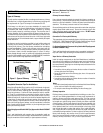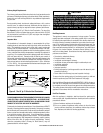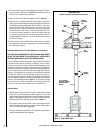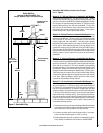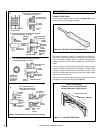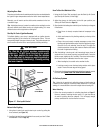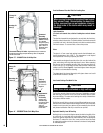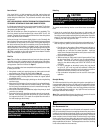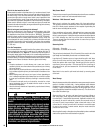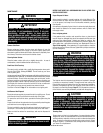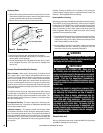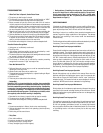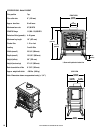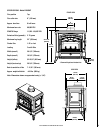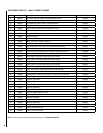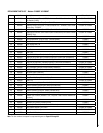
18
NOTE: DIAGRAMS & ILLUSTRATIONS ARE NOT TO SCALE
What is the best wood for the fire?
Some woods are easier to light than others (i.e. hornbeam, beech, & oak
do not light easily whereas aspen, birch and lime light easily but they do
not last as long). Then come the softwoods and conifers. Regardless if
you are burning a softer or harder wood, what is most important is that
it is well-seasoned dry wood. Damp wood has far less heating power,
this lowers the combustion temperature of the fire therefore, the output.
Green wood is difficult to light, it burns badly and gives off smoke and
causes the formation of deposits (tarring and soot staining) in the chimney
flue and on the door glass.
What is tarring and soot staining in the chimney?
When the smoke arrives in the chimney at low temperature, part of the
water vapor which they convey condenses. The heaviest constituents
are deposited on the inside of the flue (this is TARRING). The mixture
oxidizes in the air and forms brownish patches (this is SOOT STAINING).
Four essential points for avoiding these drawbacks, use dry wood, use
a stove designed for wood, connect it to a chimney with thick walls and
of suitable cross-section (size and height), and ensure the connecting
pipes are as short as possible. Horizontal pipes should be no more than
6” (150 mm).
Flue Gas Temperature
It is recommended to thoroughly heat the flue system during start-up,
before adjusting the burn rate to a medium or low setting (see How To
Start And Maintain A Fire, Page 15). To ensure that the flue system is
thoroughly heated, adjust the primary air to a medium/high position for
approximately 20-25 minutes after the start-up air is closed before adjusting
to a lower setting. This helps to establish the draft and it reduces creosote
deposits on the internal surfaces of the stove, glass and chimney.
Hints:
• Creosote condenses in a cold chimney, not a warm one. Avoid a
smoldering fire for more than a twelve-hour period and your chimney
will never get cold.
• Burn a hot fire for a short period once or twice a day (and after reload
-
ing), and then adjust the primary air draft module to a medium or low
position.
• When loading wood, add one or two logs at a time, depending on
size. Loading the appliance full of damp wood on a low fire is certain
to cause poor combustion efficiency resulting in creosote and dirty
glass.
• If the wood is not quite as dry as it should be, to assist for a short
period, smokeless coal can be added with the wood to raise the
combustion temperature.
• Have the chimney cleaned and inspected by a professional chimney
sweep once a year.
WARNING
Burning improper fuel (i.e. Charcoal) can result
in carbon monoxide poisoning which may lead to
death!
Carbon monoxide poisoning – early signs of carbon
monoxide poisoning resemble the flu with head-
aches, dizziness, or nausea. If you have these signs,
get fresh air at once! Have the heater inspected by
a qualified service technician. Some people are
more affected by carbon monoxide than others.
These include pregnant women, people with heart
or lung disease or anemia, those under the influence
of alcohol, and those at high altitudes.
Why Season Wood?
The key to the success of a good fire that produces heat from a woodstove
is the wood. It needs to be well-seasoned natural wood.
What does “Well-Seasoned” mean?
When a tree is cut down, the wood is green, full of sap and moisture.
This moisture content can exceed 80%, which must be reduced to less
than 20%. Wood properly seasoned is then capable of generating the
heat the stove was designed to provide.
Green wood does not burn easily. Attempting to burn green wood often
results in a lot of smoke and very little fire. Time is the most important
factor in seasoning wood. Ideally the moisture content should be reduced
to 11-20%, although very few of us will be able to check that figure.
There are several steps that should be taken to ensure that you come
close to these figures.
Seasoning Guide
Softwoods – 18 months
Hardwoods – 18 months to 24 months
This period can be shortened (12 to 15 months) if the wood is cut to the
right length and immediately stored under a ventilated shelter.
Logs that are 5” diameter across or larger should be split in half, three
pieces if over 8 inches, and four pieces when over a foot across (split
wood dries quicker than round logs). Round logs left in the open for
more than a year end up rotten. If the tree was fell 2 to 4 years ago, it
still needs to be cut, split, and seasoned for 18 to 24 months depending
on the wood.
Wood which is too small to split must be drained, by removing some
of the bark.
Wood Storage
Wood to be seasoned should be stacked in an area open enough to ensure
good air circulation on both sides – leaving adequate space between
woodpiles to walk comfortable. Do not stack wood against a wall or
building. It helps to elevate the wood piles off the ground (two 2 x 4’s
running lengthwise beneath the woodpile works well). This allows air to
flow under the bottom logs.
Store wood in a cool, dry place, well away from any source of flame or
heat. Keep paper, wood, rags and other easily ignited materials away
from the wood. If wood should become wet, separate it and allow it to
dry naturally; do not mix wet and dry wood or pile wet wood on top of
dry wood. If wood is kept outdoors, either covered with a tarp, or not
covered at all, it will not burn well until it has been in an enclose space
for one to two months. If stored outside, keep the wood covered to
protect from rain or snow.
Wood supplied in ready-cut lengths stored immediately under a ventilated
shelter dries quicker than wood stocked in high piles.



